North India most polluted region this winter, says CSE
analysis of winter air pollution levels and trends
As the winter season nears its end and summer trends start setting in across most regions of the country, understanding the changes in winter pollution trends across regions becomes necessary to know the challenge and depth of action needed to meet the clean air benchmark. Centre for Science and Environment (CSE) has carried out extensive analysis of real time data from cities in different regions to throw light on the difference between 2020-21 winter and the previous winters. This has been a special winter that coincides with the unlocking of the economy post pandemic linked hard lockdown phases.
“Winter is a special challenge when inversion, and cool and calm weather traps and spikes daily pollution. While the northern Indo Gangetic Plain is most affected, other regions also experience a rise, but with lesser intensity. But this year even though the average level of PM2.5 during summer and monsoon months was considerably lower than the previous year due to the summer lockdown, the winter PM2.5 concentration has risen compared to 2019 winter in many cities across regions. This bouncing back of pollution post-lockdown unmasks the high impacts of local and regional pollution. This demands quicker regional reforms to curb pollution from vehicles, industry, power plants and waste burning to curb the winter pollution and also sustain annual improvement at a regional scale with speed,” says Anumita Roychowdhury, CSE’s executive director in charge of research and advocacy.

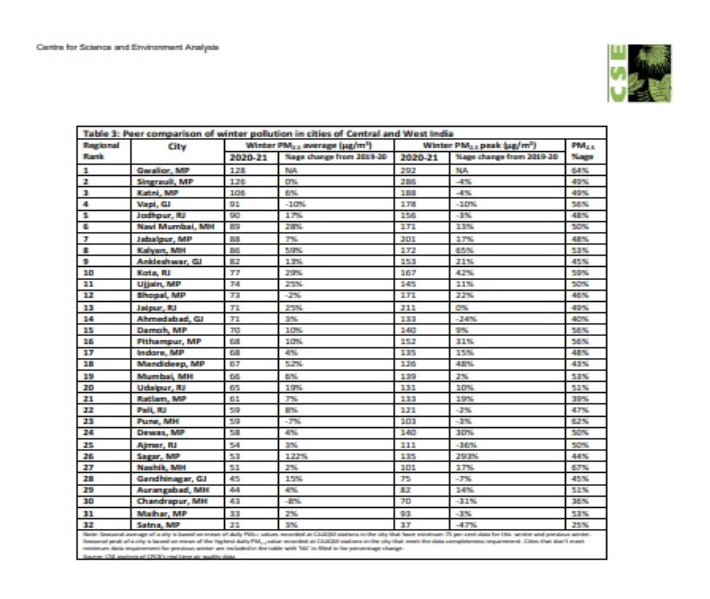
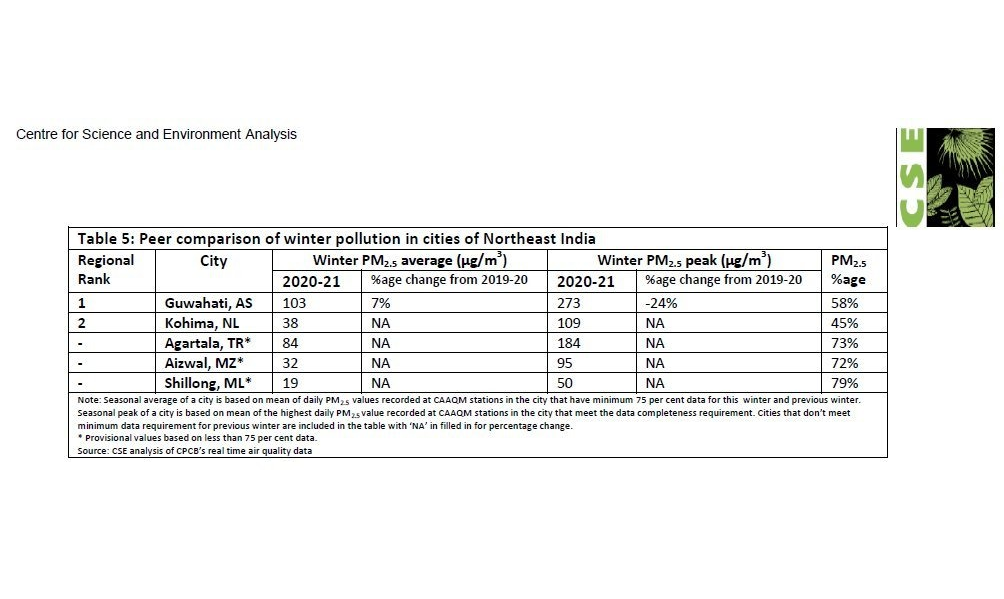
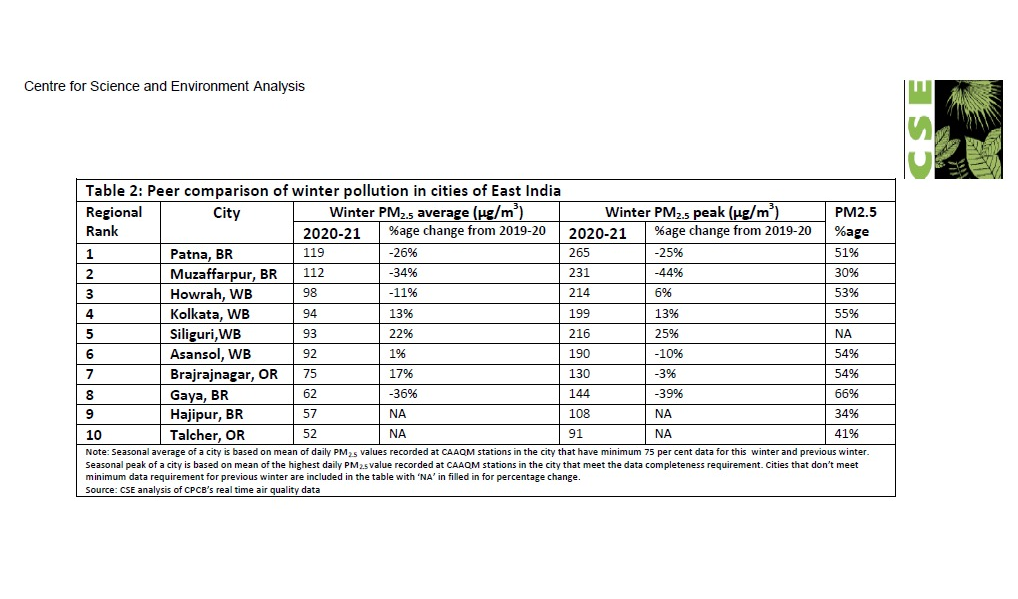
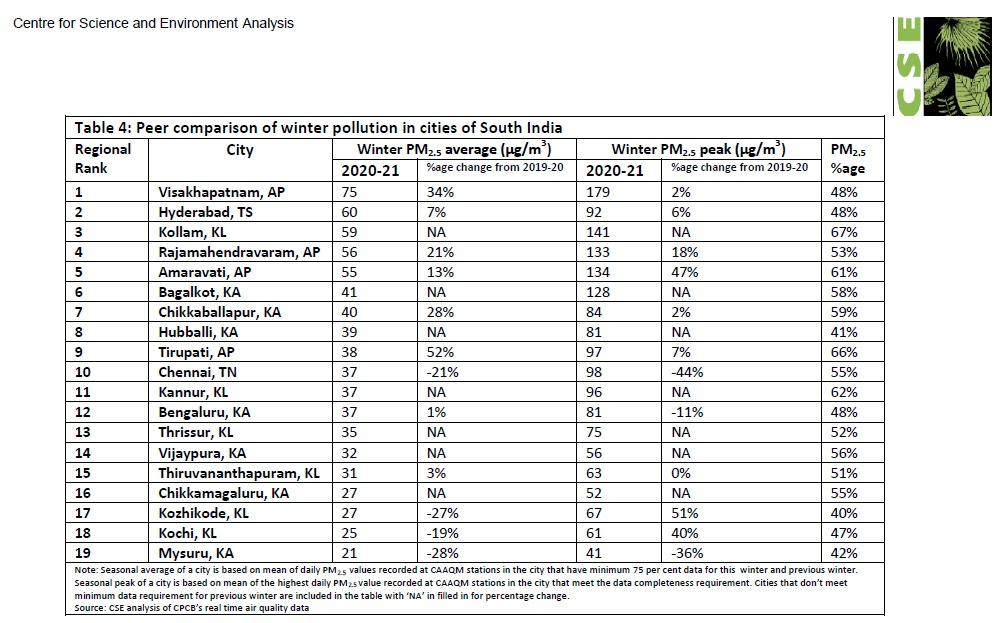
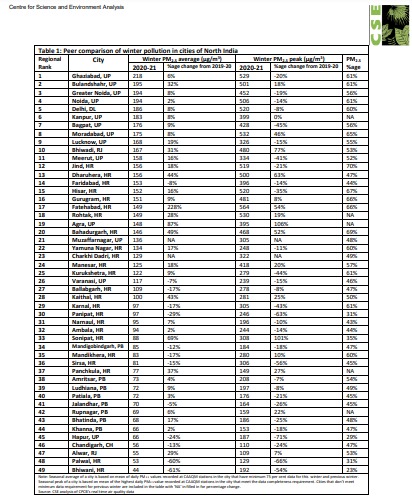
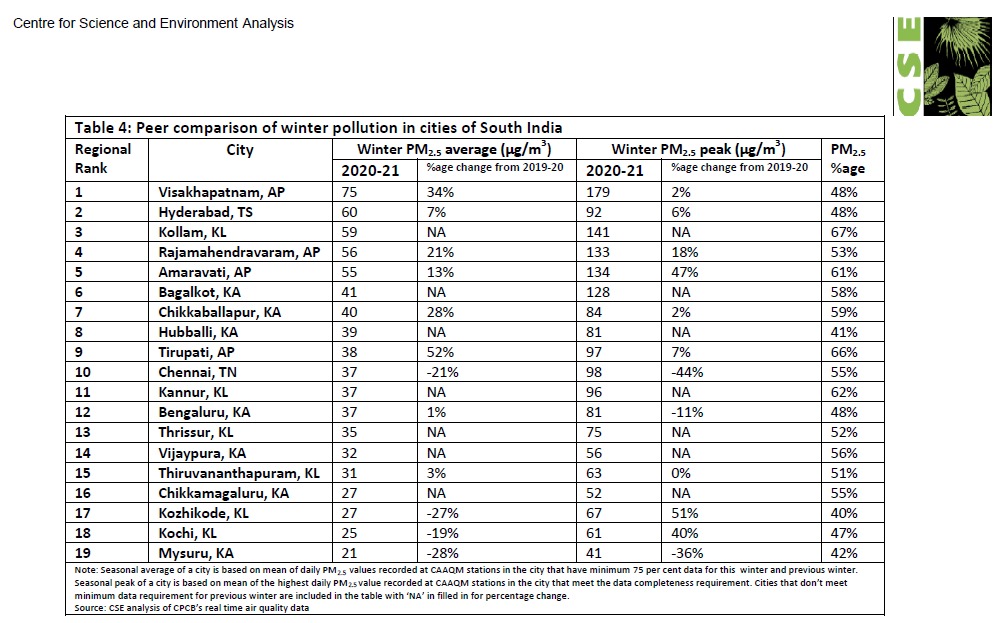
“This analysis has considered 99 cities where data availability for two consecutive winters meets the minimum criteria of 75 per cent of data completeness requirement. This analysis has helped to understand the regional differences in regional profile of winter pollution. Even though there is considerable regional variation, peak pollution episodes increased and synchronized within the regions during winter. At the same time, uneven rise across monitoring locations and contiguous cities bring out the impact of local pollution,” says Avikal Somvanshi, programme manager in CSE’s Urban Lab team of the Sustainable Cities programme.
The analysis is part of the air pollution tracker initiative of CSE. It is based on publicly available granular real time data (15-minute averages) from the Central Pollution Control Board’s (CPCB) official online portal Central Control Room for Air Quality Management. The data is captured from 248 official stations under the Continuous Ambient Air Quality Monitoring System (CAAQMS) spread across 115 cities in 22 states and union territories. CAAQMS has many more cities in its network than included in the analysis.
Key highlights
Winter pollution across all regions: a mixed trend
This analysis of PM2.5 data shows that while some cities have witnessed arresting or stabilisation of trends with small variation, others have experienced either increase or decrease. North Indian cities are on average the most polluted in the country, over three times the average of South Indian cities.
Overall winter PM2.5 levels have worsened significantly in 43 cities out of 99 cities that have valid daily PM2.5 concentration data for over 75 per cent of days for this and previous winter seasons (1-Oct to 31 Jan). This pool of cities mostly consist of Tier-1 or even smaller cities. Most prominent among them are ones in the pool are Gurugram, Lucknow, Jaipur, Visakhapatnam, Agra, Navi Mumbai, and Jodhpur. Kolkata is the only mega city in this group.
Out of the 99 cities considered, 19 have experienced substantial improvement in their winter air quality compared to the previous winter. Chennai is the only mega city included in this pool.
37 cities out of 99 cities, which include most of the mega cities, have not experienced significant change in their seasonal average compared to previous winter.
There is also wide variation in peak pollution level experienced during winter. It is noteworthy that in about 37 cities that are otherwise showing stable or declining seasonal average their peak levels have risen significantly during winter. These include Aurangabad, Indore, Nashik, Jabalpur, Rupnagar, Bhopal, Dewas, Kochi, and Kozhikode.
On the other hand, in North India, other cities including Delhi have experienced the reverse, i.e. increase in seasonal average but decline in seasonal peak.
When put in an order the top 23 polluted cities are from North India. While Mysuru is the least polluted, followed by Satna in MP and Kochi in Kerala, Ghaziabad is the most polluted city in the northern belt. There are only four cities (Satna, Mysuru, Vijaypura, and Chikkamagaluru) that have met the 24hr standard (60 μg/m3) during the winter season. Satna and Maihar in Madhya Pradesh and Mysuru in Karnataka where the cleanest cities in the country. In fact, Satna and Mysuru were the only cities to have both seasonal average below the annual standard (40 μg/m3) and seasonal peak lower than the 24hr standard (60 μg/m3).
It is important to note that mega cities are not the most polluted in any of the regions. It is the smaller and upcoming cities that are the pollution hotspots. This is even more evident in the seasonal peak data. This report findings make it is amply clear that this winter pollution challenge is not limited to mega cities or one specific region; it is an omnipresent problem and requires urgent and deliberate action everywhere. This requires quicker reforms and action in key sectors of pollution – vehicles, industry, power plants and waste management to control winter pollution and bend the annual air pollution curve.
Most polluted cities this winter were located in Delhi-NCR and UP. In fact, eight of the top 10 were UP cities with Ghaziabad and Bulandshahr taking the top spots. Delhi at number five and Bhiwadi in Rajasthan at number 10 were the only exceptions.
North India
Real time data is available for 49 cities spread across Punjab, Haryana, Chandigarh, Delhi-NCR, and UP. This also includes union Alwar district of Rajasthan as is part of NCR. Geographically this region represents the North Central Plains.
Cities with stable trend: 15 cities in the region show stable trend i.e. less than 8 per cent change from last winter. These include almost all major cities in the region. These are Faridabad, Varanasi, Jalandhar, Khanna, Noida, Ambala, Patiala, Amritsar, Rupnagar, Ghaziabad, Narnaul, Delhi, Moradabad, Greater Noida, and Kanpur.
Cities with increasing trend: 26 cities in the region show increasing trend, i.e. more than 8 per cent increase from last winter. Fatehabad in Haryana saw a staggering jump of 228 per cent in the seasonal average. It was followed by Agra that registered 87 per cent increase from last winter. Other cities that show significant increase were Bagpat, Ludhiana, Gurugram, Kurukshetra, Hisar, Meerut, Bhatinda, Yamuna Nagar, Jind, Manesar, Lucknow, Rohtak, Alwar, Bhiwadi, Bulandshahr, Panchkula, Kaithal, Dharuhera, Bahadurgarh, and Sonipat.
Cities with declining trend: 12 cities in the region show declining trend, i.e. more than 8 per cent decrease from last winter. Bhiwani and Palwal in Haryana saw a drop of over 60 per cent in their seasonal average. Other cities with declining trend are Panipat, Hapur, Mandikhera, Karnal, Ballabgarh, Sirsa, Chandigarh, and Mandi Gobindgarh.
Most polluted cluster: Most polluted cluster is the Delhi-NCR region with Ghaziabad Bulandshahr, Greater Noida, Noida, and Delhi leading the pack. Kanpur and Lucknow occupied sixth and ninth position on the chart.
Least polluted cities: Bhiwani and Palwal in Haryana and Alwar in Rajasthan recorded the lowest seasonal average during 2020-21 winter. Interestingly, Chandigarh is the only major city among the five least polluted. No city had seasonal average below the annual standard of 40 μg/m3.
East India
Realtime data is available for 10 cities spread across Bihar, West Bengal and Odisha. Geographically this region represents the Eastern Plains and Eastern Highlands.
Cities with stable trend: Asansol was the only city in the region show stable trend, i.e. less than 8 per cent change from last winter.
Cities with increasing trend: Siliguri, Bajrangnagar, and Kolkata show increasing trend, i.e. more than 8 per cent increase from last winter.
Cities with declining trend: Gaya, Muzzafarpur, Patna, and Howrah show declining trend, i.e. more than 8 per cent decrease from last winter. All Bihar cities have shown decline.
Most polluted cities: Most polluted city in the region was Patna with seasonal average of 119 μg/m3. Howrah and Kolkata occupied third and fourth position on the chart.
Least polluted cities: Talcher in Odisha and Hajipur in Bihar recorded the lowest seasonal average in the season. No city had seasonal average below the annual standard of 40 μg/m3.
Central and West India
Real time data is available for 32 cities spread across Rajasthan (except Alwar district), Madhya Pradesh, Gujarat and Maharashtra. Geographically this region represents the Arid west, Central Highlands, Northern Deccan plateau and Konkan Coast.
Cities with stable trend: 16 cities in the region show stable trend, i.e. less than 8 per cent change from last winter. These include almost all major cities in the region. These are Chandrapur, Pune, Bhopal, Singrauli, Nashik, Maihar, Ajmer, Satna, Ahmedabad, Dewas, Aurangabad, Indore, Katni, Mumbai, Jabalpur, Ratlam, and Pali.
Cities with increasing trend: 13 cities in the region show increasing trend, i.e. more than 8 per cent increase from last winter. Sagar in Madhya Pradesh saw a staggering jump of 112 per cent in the seasonal average. It was followed by Kalyan in Maharashtra that registered 59 per cent increase from last winter. Other cities that show significant increase were Pithampur, Damoh, Ankleshwar, Gandhinagar, Jodhpur, Udaipur, Jaipur, Ujjain, Navi Mumbai, Kota, and Mandideep.
Cities with declining trend: Only Vapi in Gujarat showed declining trend, i.e. more than 8 per cent decrease from last winter. It made it to the list only by a whisker as its seasonal improved by 10 per cent.
Most polluted cities: Most polluted city in the region was Gwalior with seasonal average of 128 μg/m3. Next two spot were occupied by its fellow Bundelkhandi cities of Singrauli and Katni. Bundelkhand abuts the southern border of NCR. Vapi in Gujarat, Jodhpur in Rajasthan, and Navi Mumbai occupy next three spots on the most polluted chart.
Least polluted cities: Satna and Maihar in Bundelkhand region of MP recorded the lowest seasonal average in the season. This coexistence of the most and the least polluted cities in close proximity noted in Bundelkhand is similar phenomena as noted in NCR. Chandrapur, Aurangabad, and Gandhinagar round up the list of five least polluted.
South India
The region includes 19 cities spread across Andhra Pradesh, Karnataka, Kerala, Tamil Nadu and Telangana. Geographically this region represents the southern Deccan plateau, Western Ghats, Malabar and Coramandal coasts.
Cities with stable trend: Bengaluru, Thiruvananthapuram, and Hyderabad in the region show stable trend, i.e. less than 8 per cent change from last winter.
Cities with increasing trend: 5 cities in the region show increasing trend, i.e. more than 8 per cent increase from last winter. Tirupati in Andhra Pradesh saw a jump of 52 per cent in the seasonal average. It was followed by Visakhapatnam that registered 34 per cent increase from last winter. Other cities that show significant increase were Rajamahendravaram, Amaravati, and Chikkaballapur.
Cities with declining trend: Mysuru, Kozhikode, Chennai, and Kochi showed declining trend, i.e. more than 8 per cent decrease from last winter. The improvement in these southern cities was in 19-28 per cent range.
Most polluted cities: Most polluted city in the region was Visakhapatnam with seasonal average of 75 μg/m3. Next two spot were occupied by Hyderabad and Kollam in Kerala.
Least polluted cities: Mysuru recorded the lowest seasonal average in the region. Karnataka has the least polluted cities of the region followed by Kerala. Kochi and Kozhikode of Kerala round up the list of three least polluted.
Northeast
Monitoring is very limited in this region. Data is available for only Guwahati in Assam and Kohima in Nagaland. Real-time monitoring has recently started in Shillong, Agartala, and Aizwal. But for the purpose of this analysis they do not meet the minimum data requirement. Geographically this region represents the Eastern Himalayas and Brahmaputra plains.
Guwahati has recorded worst levels in the region with seasonal winter average of 103 μg/m3. This large and populated city in the plains has a valley effect and is markedly different from other cities in the region which are located in the hills and are much smaller. City’s winter average rose by 7 per cent. (About 450 km away, Siliguri in West Bengal saw 22 per cent increase in seasonal pollution).
Kohima in Nagaland was the only other city which met the data completeness requirement in the region. With a seasonal average of 38 μg/m3 it is one of the cleanest city not just in the region but also among all other cities in the analysis. But the air quality in the city can drop to “poor” AQI category on multiple days which is a reason for concern.
Agartala, Shillong, and Aizwal also have real-time monitors that became operational only near the end of 2020. Data availability is more than 50 per cent but less than 75 per cent of the study duration. Therefore, their provisional seasonal averages have been computed but not used for comparative analysis. Agartala’s winter average of 84 μg/m3 which is more than double than the levels noted in other hill-towns of the region, in fact it is higher than all cities of south India. In Agartala PM2.5 73 per cent of PM10. This indicates highly toxic air. Influence of inert crustal dust is much less. Shillong and Aizwal also have high share of PM2.5 but significantly lower concentration.

Reported by Ms. Pratyusha Mukherjee, a Senior Journalist working for BBC and other media outlets, also a special contributor to IBG News. In her illustrated career she has covered many major events and achieved International Media Award for reporting.




















